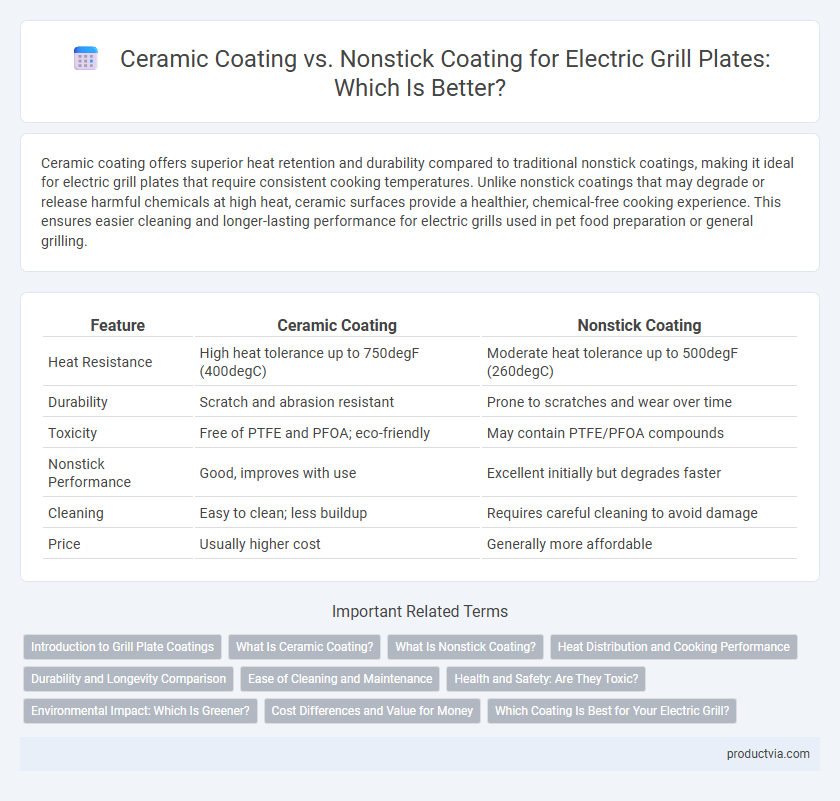Ceramic coating offers superior heat retention and durability compared to traditional nonstick coatings, making it ideal for electric grill plates that require consistent cooking temperatures. Unlike nonstick coatings that may degrade or release harmful chemicals at high heat, ceramic surfaces provide a healthier, chemical-free cooking experience. This ensures easier cleaning and longer-lasting performance for electric grills used in pet food preparation or general grilling.
Table of Comparison
| Feature | Ceramic Coating | Nonstick Coating |
|---|---|---|
| Heat Resistance | High heat tolerance up to 750degF (400degC) | Moderate heat tolerance up to 500degF (260degC) |
| Durability | Scratch and abrasion resistant | Prone to scratches and wear over time |
| Toxicity | Free of PTFE and PFOA; eco-friendly | May contain PTFE/PFOA compounds |
| Nonstick Performance | Good, improves with use | Excellent initially but degrades faster |
| Cleaning | Easy to clean; less buildup | Requires careful cleaning to avoid damage |
| Price | Usually higher cost | Generally more affordable |
Introduction to Grill Plate Coatings
Ceramic coating on electric grill plates offers high heat resistance and durability, allowing for even cooking and easy cleanup without releasing harmful chemicals. Nonstick coatings, typically made of polytetrafluoroethylene (PTFE), provide excellent food release properties but may degrade at higher temperatures, affecting longevity. Choosing between ceramic and nonstick grill plate coatings depends on desired cooking performance, maintenance, and safety preferences.
What Is Ceramic Coating?
Ceramic coating is a non-toxic, eco-friendly layer derived from natural minerals designed to provide superior heat distribution and durability on electric grill plates. It offers excellent scratch resistance and allows for easy food release without the use of chemical additives found in traditional nonstick coatings. This coating maintains its nonstick properties at higher temperatures, making it ideal for healthier grilling with less oil.
What Is Nonstick Coating?
Nonstick coating on electric grill plates is typically made from polytetrafluoroethylene (PTFE), which creates a smooth, slick surface preventing food from sticking during cooking. This coating allows for easier cleaning and reduces the need for excess oil, enhancing healthier meal preparation. Compared to ceramic coating, nonstick surfaces generally offer superior slip-resistance for delicate foods but may have lower heat tolerance and shorter durability.
Heat Distribution and Cooking Performance
Ceramic coating on electric grill plates offers superior heat distribution due to its ability to maintain consistent temperatures and resist overheating, resulting in even cooking and reduced hotspots. Nonstick coatings, while effective for easy food release, often provide less uniform heat distribution, which can lead to uneven cooking and occasional flare-ups. The durability of ceramic coatings also supports sustained high-heat performance without degrading, enhancing overall cooking efficiency and food quality.
Durability and Longevity Comparison
Ceramic coatings on electric grill plates offer superior durability and resistance to scratches compared to traditional nonstick coatings, extending the lifespan of the grill surface. Nonstick coatings tend to degrade faster under high heat and frequent use, often leading to peeling or flaking over time. Investing in ceramic-coated grill plates enhances longevity due to their ability to maintain smooth, non-reactive surfaces even after prolonged cooking cycles.
Ease of Cleaning and Maintenance
Ceramic coating on electric grill plates offers superior ease of cleaning due to its non-porous surface that resists food sticking and prevents grease buildup, reducing scrubbing time. Nonstick coatings also facilitate maintenance by allowing effortless food release but may degrade faster under high heat or abrasive cleaning tools. Choosing ceramic coating ensures durability and minimal upkeep, while nonstick coatings require more careful handling to maintain their effectiveness over time.
Health and Safety: Are They Toxic?
Ceramic coating on electric grill plates is non-toxic and free from harmful chemicals like PFOA and PTFE, making it a safer option for health-conscious users. Nonstick coatings, often containing synthetic chemicals, may release toxic fumes when overheated, posing potential health risks. Ceramic coatings also offer better heat resistance and durability, reducing the likelihood of degradation and exposure to harmful substances during cooking.
Environmental Impact: Which Is Greener?
Ceramic coatings for electric grill plates are generally considered greener due to their non-toxic composition, absence of harmful chemicals like PFOA and PTFE, and greater durability, which reduces waste over time. Nonstick coatings often involve synthetic chemicals that may release toxic fumes during manufacturing and disposal, posing environmental hazards. Choosing ceramic-coated grills supports sustainable manufacturing practices and minimizes ecological impact.
Cost Differences and Value for Money
Ceramic coating grill plates typically cost more upfront than nonstick coatings due to their durability and chemical-free composition, offering long-term value by resisting scratches and high temperatures. Nonstick coatings are generally less expensive but may wear out faster, necessitating replacement or more careful maintenance to avoid chipping and reduced performance. Investing in ceramic-coated plates provides better value for money over time, especially for frequent grilling, while nonstick options suit occasional users seeking lower initial costs.
Which Coating Is Best for Your Electric Grill?
Ceramic coatings on electric grill plates offer superior heat resistance and durability, making them ideal for high-temperature cooking with less chance of peeling or scratching. Nonstick coatings, typically made from PTFE, provide excellent food release and easy cleaning but may degrade faster under intense heat or metal utensils. The best coating depends on your cooking style: choose ceramic for longevity and higher heat tolerance, or nonstick for effortless cleanup and lower-temperature cooking.
Ceramic coating vs Nonstick coating for grill plates Infographic

 productvia.com
productvia.com